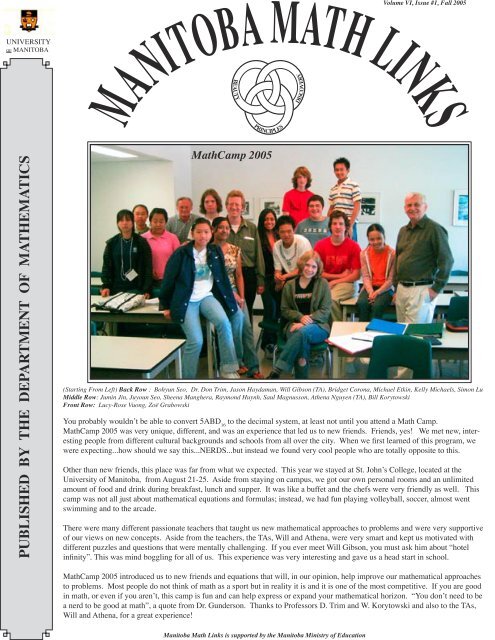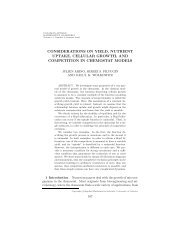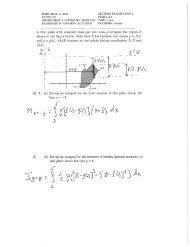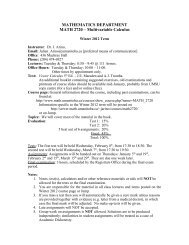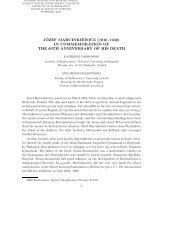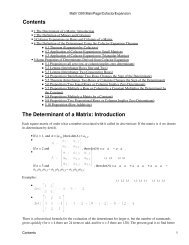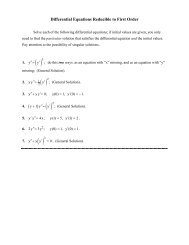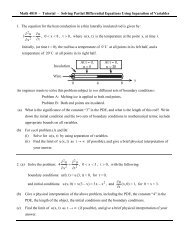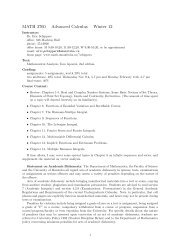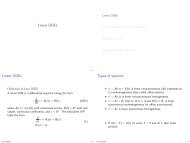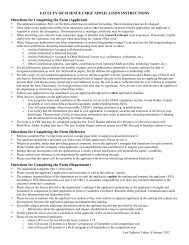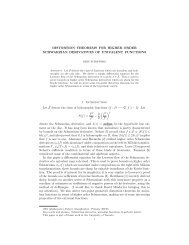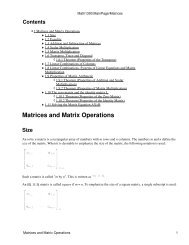Issue 13 - University of Manitoba
Issue 13 - University of Manitoba
Issue 13 - University of Manitoba
- No tags were found...
You also want an ePaper? Increase the reach of your titles
YUMPU automatically turns print PDFs into web optimized ePapers that Google loves.
Volume VI, <strong>Issue</strong> #1, Fall 2005UNIVERSITYOF MANITOBABEAUTYDISCOVERYMANITOBA MATH LINKSPRINCIPLESPUBLISHED BY BY THE THE DEPARTMENT OF OF MATHEMATICSMathCamp 2005(Starting From Left) Back Row : Bohyun Seo, Dr. Don Trim, Jason Haydaman, Will Gibson (TA), Bridget Corona, Michael Etkin, Kelly Michaels, Simon LuMiddle Row: Jumin Jin, Juyoun Seo, Sheena Manghera, Raymond Huynh, Saul Magnusson, Athena Nguyen (TA), Bill KorytowskiFront Row: Lucy-Rose Vuong, Zoë GrabowskiYou probably wouldn’t be able to convert 5ABD 16to the decimal system, at least not until you attend a Math Camp.MathCamp 2005 was very unique, different, and was an experience that led us to new friends. Friends, yes! We met new, interestingpeople from different cultural backgrounds and schools from all over the city. When we first learned <strong>of</strong> this program, wewere expecting...how should we say this...NERDS...but instead we found very cool people who are totally opposite to this.Other than new friends, this place was far from what we expected. This year we stayed at St. John’s College, located at the<strong>University</strong> <strong>of</strong> <strong>Manitoba</strong>, from August 21-25. Aside from staying on campus, we got our own personal rooms and an unlimitedamount <strong>of</strong> food and drink during breakfast, lunch and supper. It was like a buffet and the chefs were very friendly as well. Thiscamp was not all just about mathematical equations and formulas; instead, we had fun playing volleyball, soccer, almost wentswimming and to the arcade.There were many different passionate teachers that taught us new mathematical approaches to problems and were very supportive<strong>of</strong> our views on new concepts. Aside from the teachers, the TAs, Will and Athena, were very smart and kept us motivated withdifferent puzzles and questions that were mentally challenging. If you ever meet Will Gibson, you must ask him about “hotelinfinity”. This was mind boggling for all <strong>of</strong> us. This experience was very interesting and gave us a head start in school.MathCamp 2005 introduced us to new friends and equations that will, in our opinion, help improve our mathematical approachesto problems. Most people do not think <strong>of</strong> math as a sport but in reality it is and it is one <strong>of</strong> the most competitive. If you are goodin math, or even if you aren’t, this camp is fun and can help express or expand your mathematical horizon. “You don’t need to bea nerd to be good at math”, a quote from Dr. Gunderson. Thanks to Pr<strong>of</strong>essors D. Trim and W. Korytowski and also to the TAs,Will and Athena, for a great experience!<strong>Manitoba</strong> Math Links is supported by the <strong>Manitoba</strong> Ministry <strong>of</strong> Education
MANITOBA MATH LINKS WEB SITE........www.umanitoba.ca/science/mathematics(a PDF Version <strong>of</strong> Math Links is available on this website)©NEED MORE COPIES??????Feel free to reproduce this newsletter and pass it on.......!MANITOBA MATH LINKSThe Math Links Newsletter is published by theMathematics Department Outreach Committeethree times a year (Fall, Winter & Spring).IMPORTANT DATES TO REMEMBER:Evening <strong>of</strong> Excellence - U <strong>of</strong> MTuesday, October 18thEDITORS:Pr<strong>of</strong>. D. Gunderson, Editor In ChiefPr<strong>of</strong>. A. GumelPr<strong>of</strong>. R. PadmanabhanPr<strong>of</strong>. R.G. WoodsSPEAKERS AVAILABLEIf you are interested in havinga faculty member come to yourschool and speak to students, pleasecontact our Managing Editor atkangass@cc.umanitoba.ca or phone474-8703.CAREER PROFILES IN MATHEMATICSThe following web sites contain short descriptions<strong>of</strong> jobs held by individuals with a mathematics degreeand a wide variety <strong>of</strong> backgrounds:http://www.siam.org/careers/career2.htm#numberfivehttp://www.maa.org/careers/index.htmlTABLE OF CONTENTS:A NOTE FROM THE EDITORS:We welcome comments from our readers and valuetheir advice. Do you have any suggestions for improvingMath Links? Topics for new articles? Drop us aline....either by E-mail or regular mail... to the attention<strong>of</strong> our Managing Editor. We enjoy hearing from you...!Summer Math Camp Page 1What is Mathematics? Page 3Various Points <strong>of</strong> View.... Page 3Mathematics and........? Page 3 & 4Paradox in Mathematics Page 5Cool Websites Page 6Science Fair Projects Page 6 & 7Problem Corner Page 8Page 2
WHAT IS MATHEMATICS?1. Mathematics is non-existent but it makes usunderstand this existing phenomenal universe.2. Mathematics is a human-made universe.3. Mathematics is the cross-road <strong>of</strong> Arts andSciences.4. Mathematics is the Queen and Servant <strong>of</strong>Sciences.5. Mathematics is a creative art.6. Mathematics is just formalized commonsense because it merely consists <strong>of</strong> formalconsequences <strong>of</strong> self-evident truths, whichare just part and parcel <strong>of</strong> our commonintuition!Your Morning Smilesmile@globeandmail.caWithout geometry, life is pointless.- T.J. (Thom) Park, OshawaVARIOUS POINTS OF VIEW ON THECONCEPT OF A “POINT”A point is a geometric entity having nolength, width, or height.A point is an extremity <strong>of</strong> a line segment.A point is that which is indivisible.A point is that with position only.A point is an extremity which has nodimension.A point is the indivisible beginning <strong>of</strong>all magnitudes.These are not definitions <strong>of</strong> the concept <strong>of</strong> a ‘point’ ingeometry but, rather, attempts to express what alreadyone “knows” about points. But can one define theconcept <strong>of</strong> a point?MATHEMATICS AND .....???At The <strong>University</strong> <strong>of</strong> <strong>Manitoba</strong>G. Woods<strong>University</strong> <strong>of</strong> <strong>Manitoba</strong>Department <strong>of</strong> MathematicsSo, you say that you really like mathematics and you’re pretty goodat it, and you would like to take math at university..... BUT, there areother things that interest you too, and besides, you have to think abouta career someday (at least they all keep telling you that). What canyou do?If you attend the <strong>University</strong> <strong>of</strong> <strong>Manitoba</strong>, there are lots <strong>of</strong> ways inwhich you can combine your enjoyment <strong>of</strong> math with your interestin other fields. Some <strong>of</strong> them you probably know about; others maycome as news.Let’s start with a field that most people know about, namelyEngineering. If you are technically inclined, and if you enjoy andare good at mathematics and physics, this may be the field for you.Engineering involves lots <strong>of</strong> mathematics. To oversimplify somewhat,electrical and computer engineering involve the most mathematics,civil engineering involves the least, and mechanical engineering issomewhere between.A less widely known pr<strong>of</strong>ession is actuarial science. Actuaries arethe people who use mathematics and statistics to calculate what thepremiums for insurance policies, pension plans, etc. should be. Ifyou own a car, the size <strong>of</strong> your Autopac premium was worked outby actuaries, using data about past experience with claims, etc..Winnipeg has a big insurance industry (Great West Life has itsheadquarters here) and actuaries are in demand (and well paid).There are several programs at the <strong>University</strong> <strong>of</strong> <strong>Manitoba</strong> that involveactuarial science. If you are oriented towards the business world, youmight want to enter the Faculty <strong>of</strong> Management and study actuarialscience there. If you like the more theoretical aspects <strong>of</strong> the subject,you can take an Honours program in Actuarial Science, or ActuarialScience and Mathematics, or Actuarial Science and Statistics, withinthe Faculty <strong>of</strong> Science.Perhaps you like physics, but you are more interested in thescientific ideas than in the practical applications (like Engineering).To oversimplify again, physicists come in two flavours, namelyexperimental physicists (who work in labs and undertake experimentsto learn more about the universe) and theoretical physicists (whouse mathematics to construct theoretical “models” to explain theexperimental results). Albert Einstein was a theoretical physicist. Iftheoretical physics appeals to you, or if you want to learn in detailabout how mathematics can be used in a scientific field, you mightwant to enter the Faculty <strong>of</strong> Science and take a Joint Honours programin Mathematics and Physics. It contains approximately equal numbers<strong>of</strong> courses from each field.Lots <strong>of</strong> people who like mathematics also like working withcomputers. In forty years or so computer science has grown fromalmost nothing to a huge field with many different aspects. Some <strong>of</strong>them involve very little mathematics, but some <strong>of</strong> the more theoreticalaspects are very mathematical indeed. Mathematically orientedcomputer scientists (or, mathematicians with an interest in computing(continued on page 4)Page 3
(these things blur at the edges) study things like “computationalcomplexity” (i.e. how intrinsically complicated a computing problemis) and the design <strong>of</strong>computer algorithms. Maybe you have heard <strong>of</strong> Alan Turing, whowas (in essence) a theoretical computer scientist in the days beforecomputers! He was a leader <strong>of</strong> the team ( which included manymathematicians) <strong>of</strong> British code-breakers in World War II that crackedthe code that the German military command used to communicatewith its U-boats and air force. Their efforts were crucial in winningthe war. Who says that mathematics isn’t relevant?“Scientific computing” has become an important discipline in recentyears. Mathematicians use computers to work out approximatesolutions to really complicated equations that arise in engineering,physical and biological science, and finance - equations that are toodifficult to solve exactly.To prepare for a career in areas that blend computer science andmathematics in this way, you should take Joint Honours Mathematicsand Computer Science within the Faculty <strong>of</strong> Science. People with thisexpertise are very much in demand.Statistics is a math-related field devoted to drawing conclusionsabout past or future behaviour by a mathematical analysis <strong>of</strong> data. (Ifthis sounds a lot like actuarial science, don’t be surprised. Actuarialscience is more specialized than statistics, but it makes use <strong>of</strong> a lot <strong>of</strong>statistics). Statistics has both theoretical and practical components;if you are interested in the theoretical aspects <strong>of</strong> the subject, you cantake Joint Honours Mathematics and Statistics within the Faculty <strong>of</strong>Science.Mathematical economics is that branch <strong>of</strong> economics that constructsmathematical representations, or “models”, <strong>of</strong> the economy and usesthem, in conjunction with economic data, to make predictions abouthow the economy will behave in the future, and what the effects <strong>of</strong>different policy options would be on the economy. You can be surethat Alan Greenspan (Head <strong>of</strong> the U.S. Federal Reserve Board, andin effect the chief economist <strong>of</strong> the U.S. government) studied lots <strong>of</strong>mathematics. Since the “laws” <strong>of</strong> economics are not as precise asthose <strong>of</strong> physics or actuarial science, mathematical economics is notas sharp a tool as (say) theoretical physics. Nonetheless, it is used alot, and its practitioners can have rewarding careers. We have JointHonours Mathematics and Economics programs on the books, shouldyou be interested in this field.All <strong>of</strong> this just scratches the surface <strong>of</strong> pr<strong>of</strong>essions that make heavyuse <strong>of</strong> mathematics. But can’t you study math all by itself, just forfun? Do you have to be interested in using it to do so something else?Not at all - many people will study mathematics (in a major programin the Faculties <strong>of</strong> Arts or Science, or in an Honours Mathematicsprogram within the Faculty <strong>of</strong> Science) for its own sake, because it isfascinating to them.What happens to these people? A few become pr<strong>of</strong>essors <strong>of</strong>mathematics at colleges and universities, and earn their living byteaching and doing research in mathematics. (Every year researchersdiscover new mathematical concepts and truths.) Very soon therewill be lots <strong>of</strong> openings for qualified people who want to do this(“qualified” means possessing a Ph.D. in mathematics), because agreat many <strong>of</strong> those who now teach mathematics at universities andcolleges are about to retire.More generally, specializing in mathematics at university can give youa way <strong>of</strong> looking at the world, and analyzing problems, that makes youvaluable in many occupations. As an analogy, a highly conditionedathlete is in a position to become pr<strong>of</strong>icient at any one <strong>of</strong> a number<strong>of</strong> sports. A person who can write a clear, well organized persuasiveessay will be an asset in a wide range <strong>of</strong> occupations that require goodcommunication skills. Similarly, a person who understands universitylevelmathematics will be valuable in many technical and educationrelated occupations.For more information on math related careers and on choice <strong>of</strong> mathcourses in your first year at the <strong>University</strong> <strong>of</strong> <strong>Manitoba</strong>, go to ourwebsite at:http://www.umanitoba.ca/science/mathematicsthen, under “Undergraduate Information”, click on each <strong>of</strong>:Undergraduate Programs, Undergraduate Courses, Choose your Mathcourses, and Careers in Mathematics.I hope we will see some <strong>of</strong> you in our programs in future years!***********A related and growing field is the mathematics <strong>of</strong> finance. Biginstitutional investors in the stock market (pension plans, etc.) usecomputer programs to trigger decisions to buy or sell huge blocks <strong>of</strong>stock depending on the market’s behaviour. Behind these programsare mathematical “models” <strong>of</strong> how the market will work; these havebeen prepared by mathematicians who specialize in the world <strong>of</strong>finance.Maybe you didn’t know that mathematics now plays a central role inparts <strong>of</strong> the biological sciences. It is used to model the relationshipbetween predator populations and prey populations (say, owls andmice) over time. Recently, a biologically-oriented mathematician inour department was part <strong>of</strong> a team <strong>of</strong> Canadian scientists that modelledthe spread <strong>of</strong> the SARS epidemic that struck Toronto two years ago.More generally, mathematicians play a crucial role in studying howhighly contagious diseases spread. These are just a few examples <strong>of</strong>how mathematics is used in biology.Page 4
PARADOX IN MATHEMATICSN.S. Mendelsohn<strong>University</strong> <strong>of</strong> <strong>Manitoba</strong>Department <strong>of</strong> MathematicsA paradox is a situation which appears in contradiction to our intuitivenotions. Many paradoxes are merely jokes such as the one whichappears in the Gilbert and Sullivan operetta where one <strong>of</strong> the charactersmuses over the fact that he has lived 28 years but has had onlyseven birthdays since he was born on February 29. Other paradoxesare more serious in nature such as the three paradoxes <strong>of</strong> Zeno. Wewill not pursue the matter <strong>of</strong> the Zeno paradoxes here, but if the rest<strong>of</strong> this article turns out to be <strong>of</strong> interest the student would be welladvised to read up on these paradoxes. They do lead to an understanding<strong>of</strong> the notion <strong>of</strong> continuity in mathematics. In what followswe present two examples <strong>of</strong> paradoxes which arise from the analysis<strong>of</strong> baseball batting averages.In baseball the batting average <strong>of</strong> a player is defined as the number<strong>of</strong> hits divided by the number <strong>of</strong> times at bat. Baseball afficionadoslove to break down the raw statistics into various sub classifications.For instance, it is well known that players perform differently whenthey bat against left-handed pitchers. Other situations arise when theplayers bat under the stress <strong>of</strong> a “clutch” situation. There is a wealth<strong>of</strong> statistics which are kept by all pr<strong>of</strong>essional baseball teams.We present two highly paradoxical examples.Example 1.In this example we compare the batting averages <strong>of</strong> two baseballplayers and break down the times at bat to two situations - times atbat against right-handed pitchers and against left-handed pitchers.The data appears in the following tables.Table 1.TimesPlayer A at Bat Hits Av.Against right-handedpitchers 202 45 .223Against left-handedpitchers 250 71 .284Overall 452 116 .257TimesPlayer B at Bat Hits Av.Against right-handedpitchers 250 58 .232Against left-handedpitchers 108 32 .296Overall 358 90 .251Observe that B has a better batting average than A, both againstright-handed pitchers and against left-handed pitchers. But look, A’soverall batting average is better than B’s. Is there something wronghere? Yes, there is. What is wrong is our intuition about how averagesbehave. The mathematics and the answers are correct. Thiskind <strong>of</strong> paradox was first observed by E.H. Simpson in 1951. Mathematiciansand statisticians now refer to it as Simpson’s paradox.The particular example quoted here is due to Pr<strong>of</strong>. T.H. Knapp <strong>of</strong>the <strong>University</strong> <strong>of</strong> Rochester. A point <strong>of</strong> interest is that this paradoxoccurs in real life examples although not very frequently. It probablyhas occurred in real life situations during a baseball season.In the above example we have divided the batting situations into twocases. In fact, the paradox can occur by breaking down the times atbat into many types <strong>of</strong> situations. It is possible for B to be better thanA for every one <strong>of</strong> the types <strong>of</strong> situations but overall A is better thanB.The author <strong>of</strong> this note has constructed an example in which the timesat bat have been broken down into 16 categories. In each <strong>of</strong> thesecategores A is a better hitter than B but overall B is better than A (one<strong>of</strong> the categories is - batting against a right-hand pitcher with runnerson first and third base). Can you guess the other 15 categories?In our second example we consider a less complicated case - namelya breakdown <strong>of</strong> times at bat into four cases.Example 2.Statistics on a classification into four situations ( see Table 2 below).Table 2.Sit. 1. No runner on baseSit. 3. Two runners on baseSit. 2. One runner on baseSit. 4. Bases loaded.Situation 1 2 3 4A B A B A B A BTimes at bat 104 156 60 88 112 70 90 <strong>13</strong>8Hits 28 40 21 30 25 15 30 45Batting Avg. .269 .256 .350 .341 .223 .215 .333 .326In all situations A has a better batting average than B. But let us lookat the overall statistics.Table 3.Batter A BTimes at bat 366 452Hits 104 <strong>13</strong>0Batting average .284 .288Overall, B is a better hitter than A.It is an interesting exercise to construct examples like these. Thecurious student will find it worthwhile to read some literature onweighted averages. It will give him a good deal <strong>of</strong> insight into howthe paradox occurs.********Page 5
COOL WEBSITES TO EXPLOREScience Fair Projects in MathematicsR. Padmanabhan<strong>University</strong> <strong>of</strong> <strong>Manitoba</strong>Department <strong>of</strong> MathematicsCool Math Games - 15 Puzzlehttp://www.coolmath-games.com/15puzzle/index.htmlMathematics Is Everywherehttp://www.mathaware.org/mam/00/918/index.htmlPolyhedrahttp://mathforum.org/alejandre/workshops/unit14.htmlMagic Squareshttp://mathforum.org/alejandre/magic.square.htmlFractalshttp://mathforum.org/alejandre/workshops/fractal/fractal3.htmlA collection <strong>of</strong> ideas sorted by math topic, from theCanadian Mathematical Society.http://camel.cecm.sfu.ca/Education/mpsf/http://camel.math.ca/Education/mpsf/A sample list <strong>of</strong> successful Canadian math projectshttp://www.pims.math.ca/education/2000/regional/Cool Math Projects (for ages <strong>13</strong>-100)http://www.coolmath.com/Experiment-based math projectshttp://www.juliantrubin.com/mathematicsprojects.htmlThe Seven Bridges <strong>of</strong> Königsberg heralds the beginning<strong>of</strong> graph theory and topology.http://mathforum.org/isaac/problems/bridges1.htmlFamous Problems in Mathhttp://mathforum.org/isaac/mathhist.htmlBooks:[1] Howard Eves, An Introduction to History <strong>of</strong>Mathematics Holt, Rinehart and Winston, Toronto, 1986[2] Gardner, Robert. Science Projects about Math.Carolina 1999 QA40.5.G374Twenty-five projects and experiments that make use <strong>of</strong>mathematics in the context <strong>of</strong> science.*******SCIENCE FAIR PROJECTS INMATHEMATICAR. Padmanabhan<strong>University</strong> <strong>of</strong> <strong>Manitoba</strong>Department <strong>of</strong> MathematicsWhenever we think <strong>of</strong> Science museums, we usually think <strong>of</strong> hugeskeletons <strong>of</strong> dinosaurs, dancing <strong>of</strong> colorful laser beams, holographpaintings, adventures in space, etc. but never take a random walkthrough the primes! We do not see too many Mathematical displayssimply because it is thought <strong>of</strong> as an ‘abstract’ science <strong>of</strong> ideas, andat best, only “dull” write-ups in the form <strong>of</strong> posters are the commonmath exhibits.The fact is that most <strong>of</strong> the abstract mathematical concepts do arisefrom very concrete physical situations and hence it is certainly possibleto design dynamic and interactive mathematical exhibits. Here,by ‘interactive’ we do not necessarily mean just pushing buttons butthe ability <strong>of</strong> the exhibit to take along the mind <strong>of</strong> the audience to aconceptual tour <strong>of</strong> the area. The purpose <strong>of</strong> this section is to <strong>of</strong>fersome guidelines as to the nature <strong>of</strong> such mathematical topics, deepresults in that topic and a conceivable exhibit to convey the intricacy,beauty and the depth <strong>of</strong> those results.My first suggestion for such a project is the “all-pervading” Mathematicsitself! We can easily ‘picture’ mathematics in the form <strong>of</strong> atree with roots, branches, leaves, fruits and so on. The analogy mustbe pretty obvious here: roots are the foundations or the original motivationsor reasons; various branches are the ‘different’ areas <strong>of</strong> mathematics;the connecting links are the interrelations etc.. The fruits or‘gems’ as I would like to picture them are the beautiful results in thatarea: for example“e ιπ + 1 = 0” and the ‘prime number theorem’are two such gems <strong>of</strong> mathematics.You may not yet know these results and these are normally taught ina university math program.The purpose <strong>of</strong> such a tree is to point out to the students as well asthe visitors not only the historical growth <strong>of</strong> the subject but also theroute it leads to other areas <strong>of</strong> knowledge and hence will guide thestudent to chalk out a career path.You can see on the following page (page 7) a diagram <strong>of</strong> such a Tree<strong>of</strong> Mathematics.The idea that it should look more like a Banyan tree (multiple trunks)rather than an Oak tree (single trunk) goes back to Howard Eves(CF.[1] p.489). Now a concrete display would be to take such adiagram and complete it, especially on the outer boundaries, so thatit shows most <strong>of</strong> the known links to other areas <strong>of</strong> human endeavourlike Physics, Chemistry, Biology, Engineering, Economics, Architectureand even Fine Arts etc. A list <strong>of</strong> websites describing various mathprojects is given in “Cool Websites”. Good luck with your project![1]. Howard Eves, An Introduction to the History <strong>of</strong> Mathematics,Holt, Rinehart and Winston, Toronto, 1976.Page 6
Page 7
PROBLEM CORNERDear Readers:D. Trim<strong>University</strong> <strong>of</strong> <strong>Manitoba</strong>Department <strong>of</strong> MathematicsWelcome once again to the PROBLEM CORNER. Here isthe problem from the last column and its solution:Problem:Solution:A four-digit number, which is a perfect square,is created by writing Anne’s age in years followedby Tom’s age in years. Similarly, in 31 years,their ages in the same order will again form afour-digit perfect square. Determine the presentages <strong>of</strong> Anne and Tom.Their ages must be two-digit numbers, for ifeither is one-digit, the other must be three-digit,and when 31 is added to the one-digit age,the result is a two-digit number. This wouldcontradict that in 31 years juxtaposing ages isa four-digit number. Let x and y be the twodigit-ages <strong>of</strong> Anne and Tom. Then, 100x + y isa square, and we write that 100x + y =n 2 ,where n > 0 is an integer. In 31 years, theirages are x + 31 and y + 31, and we can writethat 100(x + 31) + (y + 31) = m 2 , where m > 0is an integer. When we subtract these expressions:100(x + 31) + (y + 31) - (100x + y) = 31⋅101= m 2 - n 2 = (m + n) (m-n).Since 31 and 101 are primes, it follows that m + n = 101 andm - n = 31, the solution <strong>of</strong> which is m = 66 and n = 35. Knowingthat 100x + y = 35 2 = 1225 and that x and y are each twodigit numbers, it follows that x = 12 and y = 25.I am sorry to report that I received no submissions on thisproblem. Let’s blame it on the end <strong>of</strong> year and summer holidays.Perhaps you will be able to devote some time to the newproblem.Here is your new problem:Members <strong>of</strong> the math club at your school are either teenagersor twelve year olds. When their ages are multiplied together,the product is 163,762,560.How many members does the club have?Would it be possible for the product to remain the same if the clubcontained only teenagers?Send submissions on this problem to:S. Kangas, Managing Editor<strong>Manitoba</strong> Math LinksDepartment <strong>of</strong> MathematicsThe <strong>University</strong> <strong>of</strong> <strong>Manitoba</strong>Winnipeg, MBR3T 2N2*******Four friends have been doing really well in their calculus class; they havereceived top grades for their homework and on the midterm. So when it’stime for the final, they decide not to study on the weekend before, but to driveto another friend’s birthday party in another city - even though the exam isscheduled for Monday morning. As it happens, they drink too much at theparty, and on Monday morning, they are all hungover and oversleep. Whenthey finally arrive on campus, the exam is already over.They go to the pr<strong>of</strong>essor’s <strong>of</strong>fice and <strong>of</strong>fer him an explanation, “We went toour friend’s birthday party, and when we were driving back home very earlyon Monday morning, we suddenly had a flat tire. We had no spare, and sincewere driving on back roads, it took hours until we got help”.The pr<strong>of</strong>essor nods sympathetically and says, “I see that it was not your fault.I will allow you to make up for the missed exam tomorrow morning.”When they arrive early on Tuesday morning, the students are taken by thepr<strong>of</strong>essor to a large lecture hall and are seated so far apart from each otherthat, even if they were to try, they would have no chance to cheat. The exambooklets are already in place, and confidently, the students start writing. Thefirst question - five points out <strong>of</strong> 100 - is a simple exercise in integration, andall four finish it within 10 minutes. The first to complete the problem turnsover the page <strong>of</strong> the exam booklet and reads the next one: Problem 2 (95points out <strong>of</strong> 100): Which tire went flat?*******Page 8


